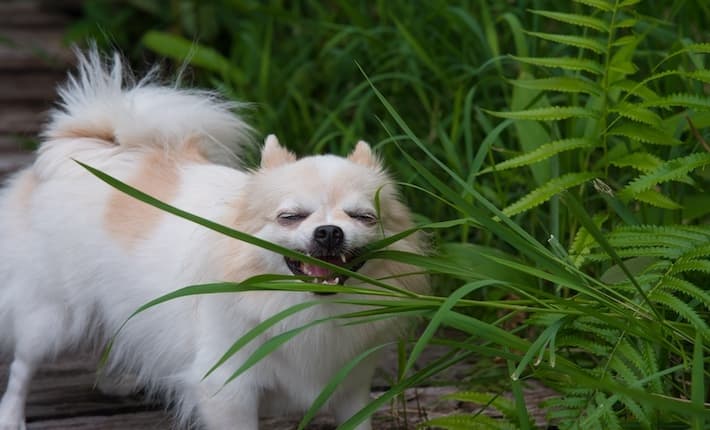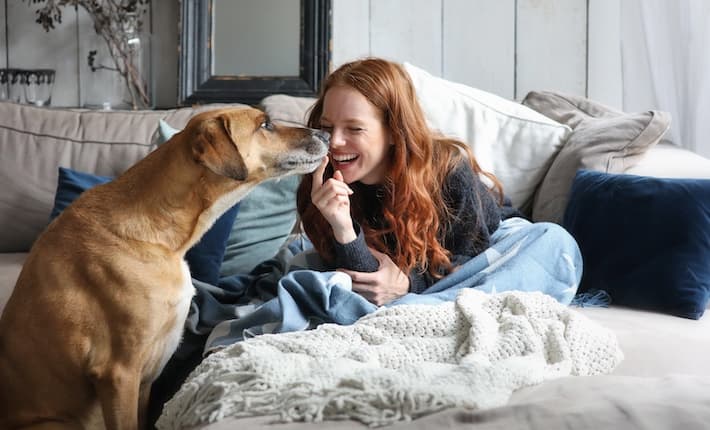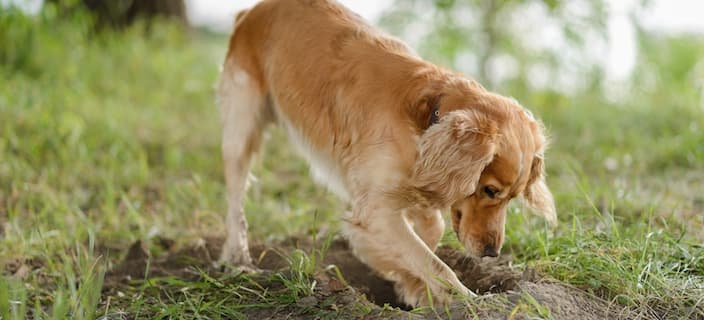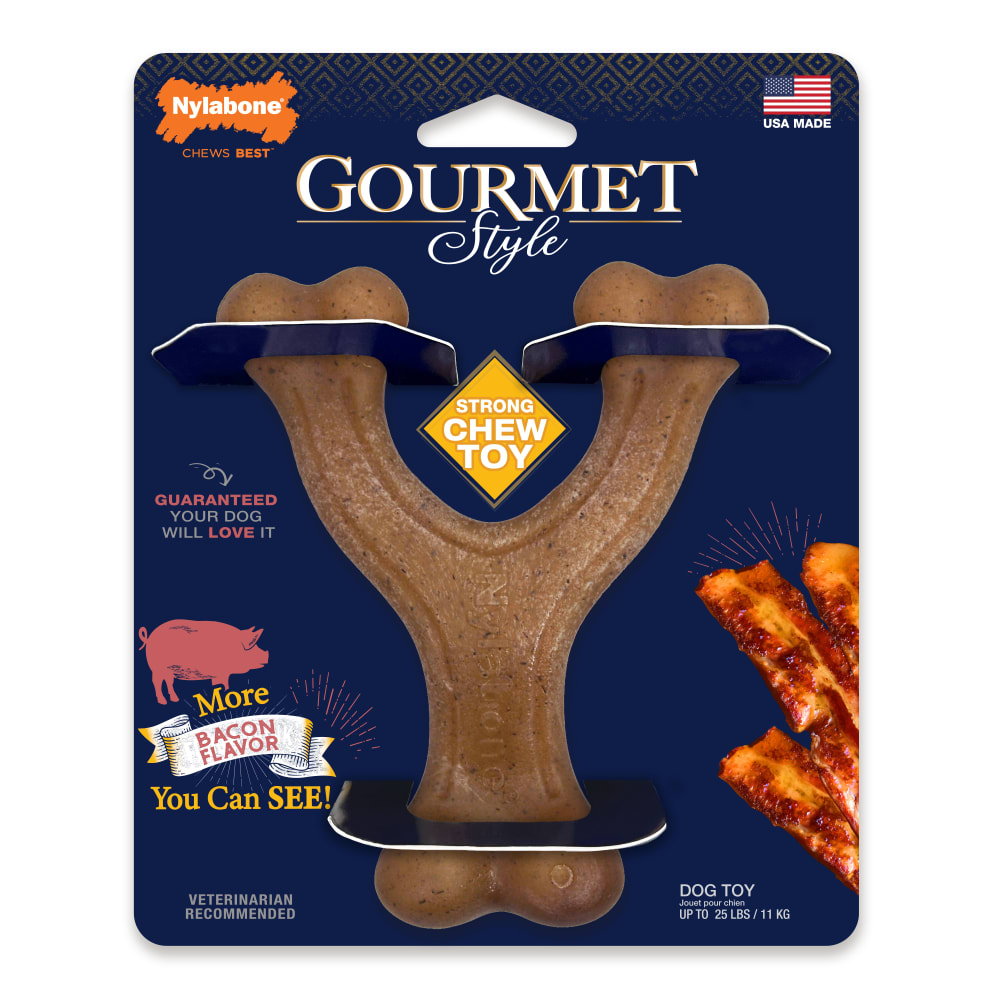13 Common Dog Behavioral Issues & Tips to Solve Them
In This Article:
#8: Eating Anything and Everything
#13: Stealing Food, Clothing, or Other Objects
Whether it’s barking at nothing, digging holes in the yard, or even gnawing on your favorite shoes, many dog behavior problems may challenge your patience.
The good news? There are ways to help solve these issues! Let’s explore 13 common problems, understand why your dog engages in them, and learn some dog behavior training tips to help.
A note before we dig in: At the first sign of a problem behavior, it’s best to work on correcting it immediately. The longer you let it go, the harder it will be to reverse. Don’t hesitate to contact a professional trainer to help with these dog behavioral issues.
Behavioral Issue #1: Barking
Although you perceive barking as a bad dog behavior, it’s a natural habit that many dogs find enjoyable!
Why Dogs Do It
Barking is your dog’s way of expressing emotions like excitement, fear, or boredom. It’s typically a way to alert you, like if a visitor is at the door or another dog’s walking down the street. Otherwise, if your dog is hungry, needs to go potty, or is just happy to see you, they’ll “woof” to capture your attention.
Tips to Help Solve It
Behavioral Issue #2: Separation Anxiety
If your dog whines, barks, or attempts to destroy their surroundings every time you leave them, they may experience dog separation anxiety. In fact, it’s one of the most common dog behavior issues affecting 76% of American dogs, according to Certapet.
Why Dogs Do It
Although there is no one answer to what causes separation anxiety, some common reasons include the feeling of rejection (especially in dogs who have experienced loneliness and isolation before), a change in routine, a new environment, or discomfort with alone time.
Tips to Help Solve It
Rehearse leaving your dog alone: The best way to acclimate your dog to your departures? Practice! Here’s a dog behavior training routine to try:
- Decide to leave the house, but don’t make a big fuss. Put your furry friend in their crate or dog room, turn on some music, quietly grab your belongings, and leave.
- Stay nearby, trying to keep an eye and ear on your dog without them knowing. If they get upset, allow them time to settle down. Otherwise, enjoy a silent cheer.
- When they’re quiet and you've been out for at least five minutes, return as if nothing happened. Put your things down and quietly & calmly greet your dog—no smothering them with affection.
- Put on their leash and take them outside, just as you would if you were returning from a longer trip. They’ll eventually learn that you care for their needs once you come home.
Repeat this a few times a day in the first days and weeks, increasing the amount of time you are gone. If you're confining them to a single room, be careful about leaving anything they can accidentally chew or consume.
If you feel you've tried your best and the situation hasn’t improved, consider working with a dog trainer and your veterinarian. Your dog may need a remedy that helps with their nerves and dog behavior training to help them cope easier.
Behavioral Issue #3: Fear of Loud Noises
If your dog’s afraid of thunderstorms, sirens, or even the vacuum cleaner, there are two main reasons why: they have acute sense of hearing and/or they associate the sound with fear.
Why Dogs Do It
Dogs can hear frequencies much higher than our own; in fact, there are some sounds only dogs can hear! So, a high buzz or loud boom can be especially overwhelming for their ears.
Additionally, dogs connect familiar sounds with feelings. This can be joyful, like keys jingling in the door meaning their favorite person is home! But it can be nerve-wracking, like firework bangs reminding them of another stressful July 4th.
Tips to Help Solve It
Play chill music: Soothing music may help them relax and drown out undesirable noises. You can even find a playlist of calm music for dogs!
Keep your cool: Your dog often takes cues from you, so set a good example.
Consider a calming supplement: There’s a variety of chews or tablets with soothing ingredients like chamomile extract or ginger root that can help pacify your dog. Talk to your veterinarian for other solutions such as a prescribed medication.
Talk to a behaviorist: If your dog is riled up no matter what you do, consult a professional to help identify the origin(s) of your dog’s stress.
🐶 Related: How to Calm an Anxious Dog: 5 Soothing Methods
Behavioral Issue #4: Destructive Chewing
First, it’s a bedroom slipper. Then it’s the dining table’s legs. It’s not long before your wonder why your dog is chewing everything in sight!
Why Dogs Do It
Your dog is a natural-born chewer. Aside from its mental and physical benefits, chewing is a fun thing to do…and not a “bad” dog behavior issue as many believe. With appropriate chewing outlets, your dog can safely indulge their natural instinct to chew.
Tips to Help Solve It
Offer chew toys: They’re a fun and flavor-packed way to let your furry friend do what they want: chew! There are many options to choose from, including cute chew toy shapes, intriguing textures, and engaging flavors your dog will love. Chew toys not only entertain, but they help encourage positive chewing habits in the future.
Behavioral Issue #5: Digging
Just like chewing, digging is a natural instinct for dogs. However, you’ll want to set some boundaries to ensure your furry friend isn’t creating holes around your yard!
Why Dogs Do It
This bad dog behavior is more common in breeds like terriers or hounds who were bred to hunt burrowing animals. Your dog might start digging out of excitement if they sense a creature underground, or they may be trying to stash their favorite toys—just how their wolf ancestors stored their food. And, as with many dog behavioral issues, boredom can also be to blame!
Tips to Help Solve It
Embrace the desire to dig: Set up a small sandbox in your yard where your dog can satisfy their instinct to dig. To encourage them to use that spot, bury something they need to dig out and offer lots of praise when they do.
Redirect the behavior: If you don’t have a dedicated outdoor spot and your dog starts digging, they’re probably bored. Grab a dog play toy and start a round of fetch. The same goes for indoors—your dog needs something better to do! Take them to their crate, bed, or dog room to enjoy a chew toy.
Behavioral Issue #6: Excessive Licking
Occasional self-grooming is normal…to a degree. It’s typical for dogs to lick their paws, legs, or tail to remove debris. But if your dog is excessively licking and you suspect something is up, you’re probably right!
Why Dogs Do It
Dogs sometimes lick to ease skin irritation, a food allergy, an ache, or even a parasite. It’s best to talk to your veterinarian to rule out more serious issues.
Otherwise, the licking is a behavioral issue rooted in boredom or anxiety—and there’s plenty you can do to keep your dog occupied!
Tips to Help Solve It
Provide mental stimulation: It’s time to change up your furry friend’s routine. Playing tug-of-war with your dog, teaching them a new trick, or exploring a new walking route are all simple things you can try today.
For an independent activity, toys are an easy, fun way to help keep your dog’s brain busy. This could be anything from a durable chew toy that helps your dog unwind to a more challenging puzzle or treat toy that delivers the enrichment they crave.
Create a calm environment: Just as mental stimulation can help ease feelings of stress, so can a relaxing space! Provide your furry friend a safe area to retreat, especially when they feel anxious.
Behavioral Issue #7: Aggression
It can be tricky to tell the difference between dog aggression vs. playing, especially because aggression can manifest in many ways.
Does your dog stand and guard their food bowl? Do they bare their teeth at you when you try to grab their toy? Does their tail go high and stiff when they encounter another dog? These are all signs of aggressive tendencies.
Why Dogs Do It
From territorial aggression to frustration aggression, there are different types of dog aggression. Further, there are several causes of dog aggression, but most come down to one word: stress. Dogs who are afraid of other animals or feel compelled to protect their belongings from an outsider are most likely to exhibit this behavior.- Exposed teeth
- Ears flattened against the head
- A hard stare
- Panting
- A high and stiff tail
- Sudden yawning
Tips to Help Solve It
- Stay calm: Instead of an emotional reaction like yelling or stomping, maintain a calm voice and composed demeanor.
- Reward good behavior only: Distracting your dog with a treat or toy will send the wrong message. Only offer rewards once they simmer down.
- Alter their surroundings: Adjust your dog’s immediate environment, like removing the person or animal who’s triggering the behavior.
- Use a muzzle: Dog muzzles can help in certain scenarios where your dog is especially excitable, such as an at-home grooming session or introduction to a new pet.
Behavioral Issue #8: Eating Anything and Everything

Furry friends who regularly eat nonfood items may suffer from pica in dogs, a condition where they’re compelled to eat grass, sticks, rocks, other animals’ droppings (known as coprophagia in dogs)—the list goes on.
Why Dogs Do It
Dogs are descendants of wolves, so it makes sense that their eating habits are rooted in history. Because not all hunting expeditions were successful, wolves needed to eat what they could to survive.
Other factors at play include attention-seeking behavior, dog boredom, the desire to clean up their space, or plain ol’ hunger.
Tips to Help Solve It
Restrict access to trash: Be sure to clean up your yard and keep trash cans securely closed.
Eliminate table scraps: If your furry friend already tends to eat everything, feeding them from the table only reinforces pica in dogs.
Increase meals: Talk to your veterinarian about your dog’s current mealtime routine and possible tweaks to keep them better satisfied.
Give a stool eating deterrent: If your dog is eating their own feces, find a product that discourages the behavior. Our friends at Four Paws make Potty Mouth, a stool eating deterrent that’s formulated with cayenne pepper to make stool unattractive and yucca schidigera extract to reduce stool odor.
Keep your dog entertained: Going on walks, playing games, offering toys, and generally engaging in exercise will give your dog more to think about than what they can get their mouths on next!
Behavioral Issue #9: Begging
We can’t blame our furry friends for wanting to taste what we’re eating, but begging for food can quickly turn into a dog behavioral issue you face daily. It’s easier to prevent this habit than to reverse it completely, so create good habits as early as possible.
Why Dogs Do It
Like chewing and digging, begging may be rooted in our dog’s instincts. Because their wild ancestors didn’t get regular meals, they needed to eat whenever they could. This means your dog has a natural knack for sniffing out tastiness!
Plus, if you’ve ever snuck your dog a table scrap (we’ve all been there), you’ve unfortunately taught them that their begging worked, and it’s now a learned behavior.
Tips to Help Solve It
Dine separately from your dog from the start: If you have a new furry friend in your home, start this routine from day 1! When it's time for you to eat, put your dog in their crate or another room with an occupying chew toy. Only let them out when you're finished.
Confine your dog once they beg: It’ll be tough, but try to endure the barking and whining for as long as it takes. Once your dog quiets down, let them out. If you repeat this enough, they should learn that begging will not get them what they want.
Feed leftovers in their food bowl: If you want to feed leftovers (just make sure they’re healthy human foods for dogs!), put them in your pup’s designated food bowl so it’s a regular part of their meal time.
Behavioral Issue #10: Jumping
A jumping dog is hard to ignore! In fact, that’s likely why your dog jumps in the first place—to get your attention. While your dog’s intentions may be honorable, there are ways to help them avoid this bad dog behavior.
Why Dogs Do It
Jumping is your dog’s way of saying “Hi, hey, hello!” Aside from wanting to greet you, they also may be excited about hearing someone at the door or seeing another dog.
Other reasons could be anxiety or fear, but it’s not as common. If you think that’s possible, talk to your veterinarian or a behaviorist.
Tips to Help Solve It
Master the “sit” command: Your dog can’t jump if they’re sitting down! Find a family member, friend, or neighbor to play “the guest” in this dog behavior training exercise:
- Put your dog on their leash and have someone ring the doorbell.
- Tell your dog to sit.
- If they sit, you open the door. If they don't sit, wait until they do.
- When the guest comes in, hand them a couple dog treats and ask them to give the “sit” command. If your dog sits, they get a treat. If they don’t sit, your guest turns their back on the dog for a moment while you hold their leash to ensure they don’t jump.
- Both you and your guest should repeatedly ask the dog until they comply.
Behavioral Issue #11: Playing Too Roughly
Mouthing, tugging, wrestling, and chasing are all common ways dogs play, but sometimes sessions get a little too action-packed. In these cases, it's critical to settle rough play immediately.
Why Dogs Do It
Like jumping, dogs play rough usually out of excitement. Younger dogs especially may not comprehend boundaries, so they need to learn what’s acceptable and what’s not. Otherwise, if they learned that rough behavior gets your attention, it’ll become a learned behavior.
Tips to Help Solve It
Create a calmer mood: You set the tone! Stop moving, quiet down, and keep your hands & arms close to your body. Even if your dog’s jumping on you, act like a statue. The same goes for anyone else who’s playing at the time; everyone should stop paying attention to the dog.
Give a time-out: Once your dog’s settled enough to physically handle them, pick them up or lead them to their crate or room for a time-out.
Reinforce appropriate behavior: You can have another play session later—but be firm in how you manage it. As soon as your dog gets overexcited, calm them down and stop. You can even run through some obedience training exercises to reinforce that you're the leader.
Behavioral Issue #12: Submissive Urination
If your dog has ever wet themselves when you greet them, scold them, or meet new people, you may have a submissive urinator.
Why Dogs Do It
As the name suggests, submissive urination is an act of deferring to someone else (in many cases, you, because you’re the one in charge). Your dog may tinkle to diffuse tension, let you know they come in peace, or signal they’re uneasy.
Tips to Help Solve It
Rule out health issues: First, check with your vet to make sure the problem isn't due to something else.
Confine your dog to an easy-clean spot: If you know there’s a good chance your dog will urinate, at least avoid it being on carpet.
Greet them with minimal emotion: When you approach your dog after being away for a bit, be as emotionless as possible. Our furry friends can pick up on our feelings, which can contribute to their own anxiousness. If you suspect your dog will urinate, avoid acting reluctant, anxious, or generally suspicious.
Lead them outside ASAP: Pretend they’re a stranger whom you must take outside as calmly and quickly as possible. If they urinate on the way, don't react. Keep heading outside and let them do their thing. Confine them again while you clean up any messes, and then get on with the rest of your day. Repeat this process!
Behavioral Issue #13: Stealing Food, Clothing, or Other Objects
That single sock that randomly disappears? We can relate. Fortunately, stealing is among the easiest dog behavior problems to solve. After all, your dog can't steal what they can't access!
Why Dogs Do It
If your dog ever snagged a snack from the table, it could be because they couldn’t resist the delicious scent. And if you then chased after them, they thought you just started a fun game! Knowing they got a reaction from you could prompt them to try it again, so it’s best to avoid indulging these antics.
If your dog’s stealing personal items like socks or clothes, it’s because the items carry your familiar scent. It may be annoying, but the sentiment is sweet; they’re trying to feel closer to you, especially if you’ve spent some time away.
Otherwise, like many dog behavior problems, your furry friend may just be bored. Be sure to have other activities on hand: a mentally stimulating treat toy, an engaging chew toy, or play toys for some interactive fun.
Tips to Help Solve It
Resist a game of chase: If your dog does steal something, don't chase them, or you're initiating a game. Call them to you or go after them methodically and unemotionally until you can hold them. Give them the "leave it" command as you open their mouth. Just be careful doing this; if you sense your dog is getting aggressive, leave them be and confine them. If it happens repeatedly, consider visiting a behaviorist.
On Your Way to a Well-Behaved Best Bud

Whether training your dog to learn a new behavior or modifying an existing habit, it's important to remember that every dog is different, and some tips may work better for some than others!
As you monitor your furry friend’s behaviors, stay as objective as possible. This will help you truly determine the source of the problem or what’s triggering them. Involve everyone in your household in the game plan to try to solve any dog behavioral issues.
Finally, if you aren't succeeding but know something must be done, seek professional help. With lots of commitment and patience, your dog will reward you with their love and trust!
FOLLOW US!






